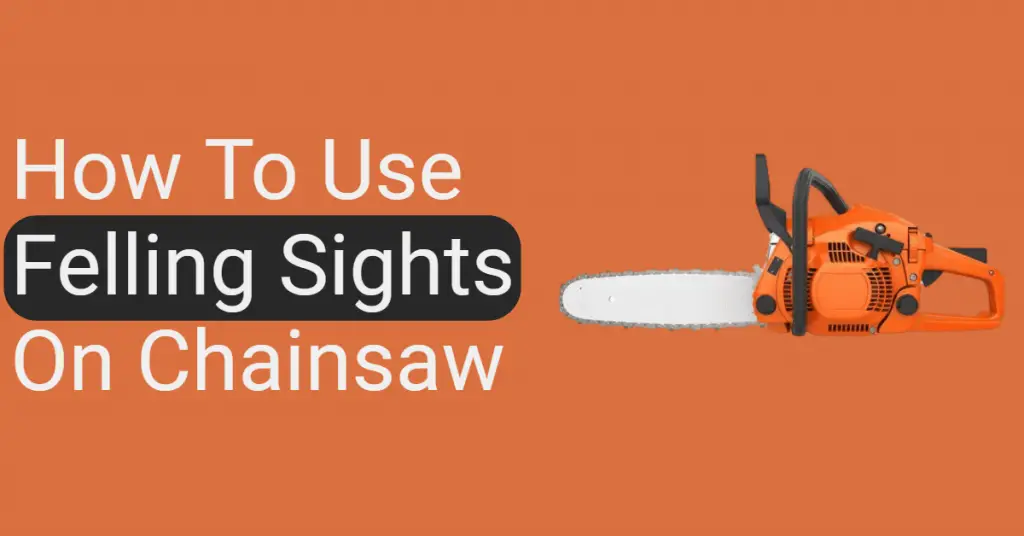How To Use Felling Sights On Chainsaw? (Explained)
A chainsaw is a powerful tool and efficient to bring the whole tree down.
However, before starting with the tree-felling daunting task, ensure to take essential precautions.
Following best practices maximizes your safety and brings down a tree effectively.
There is a need to understand the procedure of felling trees using a chainsaw.

What are the felling sights?
Saw operators are the people who know to use the chainsaw the felling sights. A ninety degrees line is perpendicular to the guide bar.
The felling sight is useful to place a tree, with proper hinge strength and lean calculation, in the place you want.
Sighting requires you to stand behind the sight line, to aim at a tree.
Aiming a tree towards the lay or target area requires you to start with the face notch cut.
You may do this, you send the limb or tree in the wrong direction.
The sighting does not take the planning importance forward to lean back.
The hinge techniques and sighting work on the ground, from a bucket work position, or in the tree.
The felling sights five-step plans
The felling sight’s five-step plans are the cutting methods that are up-to-date and are in use worldwide by professional chainsaw operators.
Using these felling plans helps achieve consistently successful results.
Step 1- Identify the hazard and the height–
You must decide the desirable direction before felling the tree.
Determine the tree height using a relative method to know the relative direction of the fall.
Look for tree decay, defects, electrical conductors, or other tree characteristics that may affect or hinder the felling plan.
Go through the obstacles of the felling site; look for obstacles, such as pavement, structures, and outdoor furnishings.
If necessary, some may be moved, while others may be avoided.
It is necessary to assess the wind direction and strength before using felling sights on a chainsaw.
Step 2- Calculate side lean
Determining if the hinge will hold or not is essential so that you can remove some bad side weight.
Determining the sides as good and bad is important for the feller before making the final cut.
Step 3- Escape route
Always consider the escape route before initiating the felling operation.
It should be on the opposite side of the felling direction at a 45-degree angle.
You may walk the escape route and check before finalizing the felling cuts.
Thus, you can clear the hazards or obstacles before you begin felling the tree.
Consider using the escape route before or as the tree starts to fall.
Step 4 – Hinge plan
The hinge and face notch are vital to be accurate, safe, and offer consistent felling results.
Plan the depth, size, and notch placement. Determine the hinge length and the desired thickness.
Step 5 – Back cut technique –
The back cut is not taken seriously and it is mostly the main reason for felling accidents.
The back or forward lean determines the back cut to use.
The straightforward bore or back cut is the degree of back or forward lean determining the wedges and if a pull rope is necessary.
Even then, how much power is required to move or pull a tree over the hinge that is the pivot point?
Bear in mind, that for a too thin tree, enough wood for a hinge bore cut, a notch, and a holding or back strap are not enough.
Thus, it is not necessary to use the forward straight back cut.
Make a note to finish the felling on the good side of the tree and to use the escape route once the tree starts to fall.
Felling cuts using the chainsaw
If you notice the chainsaw jams, you may switch it off.
Gently, pull the chainsaw to ensure it is dislodged.
If not, use the correct tools and open the cut.
Take appropriate measures to ascertain whether the tree is to be left or you maintain perfectly the exclusion zone.
Reassess the situation before the felling operation.
Use appropriate felling aids when necessary. Use a breaking bar and lever the tree.
Using the legs, keep the back straight to lift. Keep both hands on the lever.
As a felling cut began on a tree, do not leave the tree standing.
Again, never start some other new operation, before the tree falls.
As the tree starts to fall, move 3 meters at least into the escape route. It is to ascertain a safe distance of the tree from the butt.
Monitor the tree movement, and watch for falling tops and branches.
Beware of the rebounding butt or the whole tree sliding as you are felling on a slope.
Assess the risk situation as the tree is lodged and determine if it can be dealt with safely, immediately, and effectively with the available equipment to the operator.
If it is difficult, tape off the danger area of the tree.
At the same time, before felling, ensure no other person is in a distance equal to the tree length twice the time or below the steep slopes.
Takedown hung up a tree with proper lifting techniques.
It is because there are limitations in using manual aid tools, as it is to deal with heavy loads.
If essential, use mechanical assistance.
Assess carefully the tree, decide the most effective and safest way of taking it down, and recognize the danger areas.
While using a chainsaw, remove all the hinge parts and work at the tree side from a safe position.
Do not consider the tree felling of any supporting tree while attempting to free any hung-up tree.
Likewise, if you climb a hung-up tree, do not dislodge the supporting tree.
Do not cut the butt end pieces or try to dislodge a hung-up tree.
Wrapping up
Rolling lodged trees requires maximum advantage and a pushing movement.
A muscular effort is available on keeping the lever at the chest and waist in-between heights.
Always, stay outside the danger zone. Use a pole to move the butt and push using the legs, keeping behind the pole.
As the tree starts to fall, you may let go of the lever or pole.


